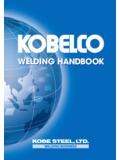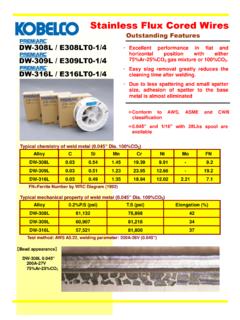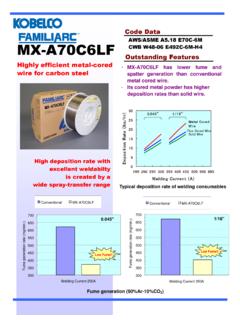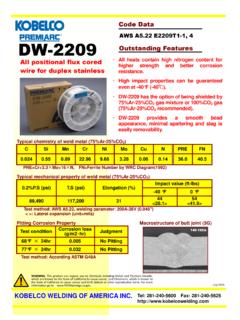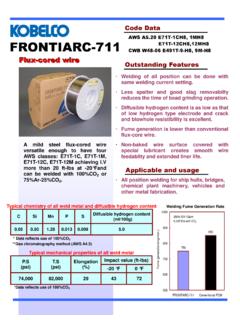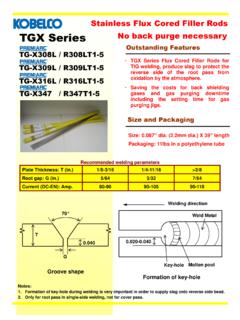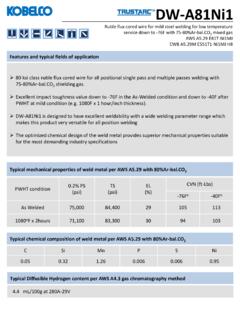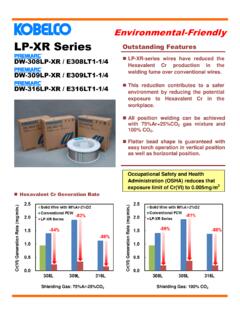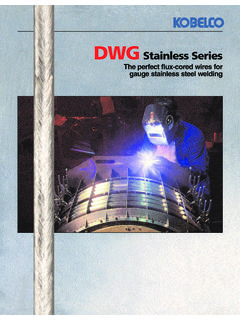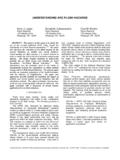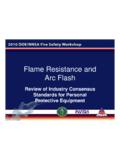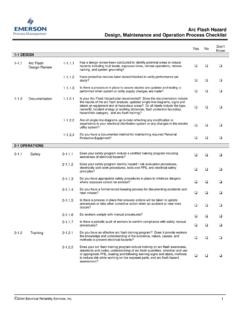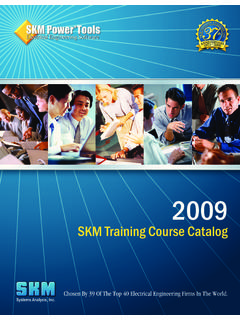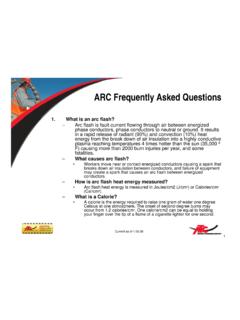Transcription of SAFETY DATA SHEET - Kobelco Welding
1 SDS No.: US-E FRONTIARC-711 Format / data Date of issue: 2015-05-20 1 SAFETY data SHEET 1. PRODUCT AND COMPANY IDENTIFICATION Trade designation FRONTIARC-711 Recommended use For Welding Restrictions on use Do not use except for Welding . Manufacturer Manufacturer's Name: KOBE STEEL, LTD. Address: 5-9-12 Kitashinagawa Shinagawa-Ku Tokyo JAPAN Phone number: +81-3-5739-6331 Fax number: +81-3-5739-6960 Emergency phone number:+81-3-5739-6331 Distributor Distributor's Name: Kobelco Welding OF AMERICA INC. Address: 4755 Alpine Rd. Ste 250 Stafford, Texas Phone number: 281-240-5600 Fax number: 281-240-5625 Emergency phone number:281-240-5600 2. HAZARDS IDENTIFICATION Classification according to OSHA Hazard Communication Standard (29 CFR ) and the Canadian Controlled Products Regulations. Hazard classification Classification not possible as hazardous according to GHS classification.
2 Label elements Symbol: Not applicable Signal word: Not applicable Hazard statement: Not applicable Precautionary statement: Not applicable Other hazards which do not classified in GHS classification General: When this product is used in a Welding process the hazards are electric shock, fumes, gases, radiation, spatter, slag and heat. Read and understand this SAFETY data Sheets and the manufacturer s instructions and the precautionary labels before using this product. Shock: Electrical Shock can kill. Radiation: Arc rays can injure eyes and burn skin. Fumes: Overexposure to Welding fumes result in symptoms like dizziness, nausea, dryness or irritation of the nose, throat or eyes. Chronic overexposure to Welding fumes may affect respiratory system and nervous system. Substance(s) formed under the conditions of use The Welding fumes produced from this Welding electrode may contain the listed constituent(s) of and/or their complex metallic oxides as well as solid particles or other constituents from the consumables, base metal, or base metal coating not listed The Welding fumes may contain Mn, Ni, Cr(VI) and their compounds.
3 Refer to and 10. Gases: Gases may cause gas poisoning. Under conditions of use, gases may contain carbon oxides, nitrogen oxides, ozone etc. Refer to and 10. Spatter, slag: Spatter, slag can damage eyes. Heat: Spatter, slag, melting metal, hot welds, arc rays and sparks can cause burn injuries and ignite combustibles and flammable materials SDS No.: US-E FRONTIARC-711 Format / data Date of issue: 2015-05-20 2 3. COMPOSITION / INFORMATION ON INGREDIENTS Substance/Mixture Mixture Chemical name CAS No. Concentration range (%)Iron Titanium dioxide Manganese Silicon dioxide Silicon Magnesium Zirconium oxide Potassium silicofluoride 7439-89-6 13463-67-7 7439-96-5 7631-86-9 7440-21-3 7439-95-4 1314-23-4 16871-90-2 Balance 8 3 1 1 1 1 1 4. FIRST AID MEASURES Description of first aid measures Inhalation: Remove person to fresh air and keep comfortable for breathing and get medical advice/attention.
4 If breathing has stopped, perform artificial respiration and get immediate medical advice/attention. Skin contact: Take off contaminated clothing and rinse skin with soap and water [or shower]. If skin irritation occurs, get medical advice/attention. For reddened or blistered skin, or thermal burns, get medical advice/attention. Eye contact: Rinse cautiously with water for several minutes. Remove contact lenses, if present and easy to do. Continue rinsing. Get medical advice/attention. Arc rays can injure eyes. If exposed to arc rays, move victim to dark room, remove contact lenses as necessary for treatment, cover eyes with a padded dressing and rest. If symptoms persist, get medical advice/attention. Electric shock: Disconnect and turn off power. If the victim is semi- or unconscious, open the airway. If the victim cannot breath, give artificial respiration.
5 If there is no pulse, massage the chest and apply artificial respiration. Ingestion: Unlikely due to form of product, except for granular materials. If ingested, Rinse mouth. Do NOT induce vomiting. Immediately call a POISON CENTER/doctor. Most important symptoms/effects, acute and delayed Symptoms: Short-term (acute) overexposure to Welding fumes may result in discomfort such as metal fume fever, dizziness, nausea, or dryness or irritation of nose, throat, or eyes. May aggravate pre-existing respiratory problems ( asthma, emphysema). Long-term (chronic) overexposure to Welding fumes can lead to siderosis (iron deposits in lung), central nervous system effects, bronchitis and other pulmonary effects. Refer to Section 11 for more information. Hazards: Welding hazards are complex and may include physical and health hazards such as but not limited to electric shock, physical strains, radiation burns (eye flash), thermal burns due to hot metal or spatter and potential health effects of overexposure to Welding fume or dust.
6 Refer to Section 11 for more information. Indication of immediate medical attention and special treatment needed Treatment Treat Symptomatically. 5. FIRE-FIGHTING MEASURES General fire hazards As shipped, this product is nonflammable. However, Welding arc and sparks can ignite combustibles and flammable products. Read and understand American National Standard , " SAFETY In Welding , Cutting and Allied Processes before using this product. Suitable (and unsuitable) extinguishing media Suitable extinguishing media: As shipped, the product will not burn. In case of fire in the surroundings, use CO2, powder or water spray. Unsuitable extinguishing media: None known Specific hazards arising from the chemical SDS No.: US-E FRONTIARC-711 Format / data Date of issue: 2015-05-20 3 None known Special protective equipment and precautions for fire-fighters Special protective equipment: Selection of respiratory protection for fire-fighting: follow the general fire precautions indicated in the workplace.
7 Self-contained breathing apparatus and full protective clothing must be worn in case of fire. Special precautions: Use standard firefighting procedures and consider the hazards of other involved materials. 6. ACCIDENTAL RELEASE MEASURES General Unlikely due to form of product, except for granular materials. The Welding fumes and slags may be released. Personal precautions, protective equipment and emergency procedures If airborne dust and/or fume is present, use adequate engineering controls and, if needed, personal protection to prevent overexposure. Refer to recommendations in Section 8. Methods and material for containment and cleaning up Clean up spills immediately, observing precautions in the personal protective equipment in Section 8. Avoid generating dust. Prevent product from entering any drains, sewers or water sources. Refer to Section 13 for proper disposal.
8 Environmental precautions Avoid release to the environment. Prevent further leakage or spillage if safe to do so. 7. HANDLING AND STORAGE Precautions for safe handling Reduction of fumes and dusts: Keep formation of airborne dusts to a minimum. Provide appropriate exhaust ventilation at places were dust is formed. Read and understand the manufacturer's instruction and the precautionary label on the product. See American National Standard , " SAFETY In Welding , Cutting and Allied Processes" Prevention of electric shock: Do not touch live electrical parts such as the Welding wire and Welding machine terminals. Wear insulated gloves and SAFETY boots. If Welding must be performed in damp locations or with wet clothing, on metal structures or when in cramped positions such as sitting , kneeling or lying, or if there is a high risk of unavoidable or accidental contact with workpiece, use the following equipment: Semiautomatic DC Welder, DC Manual (Stick) Welder, or AC Welder with Reduced Voltage Control.
9 Prevention of fire and explosion: Remove flammable and combustible materials and liquids. Prevention of harm when handling Welding consumables: Handle with care to avoid stings and cuts. Hold the Welding wire manually when loosening the wire. Conditions for safe storage, including any incompatibilities Store Welding consumables inside a room without humidity. Do not store Welding consumables directly on the ground or beside a wall. Keep Welding consumables away from chemical substances like acids which could cause chemical reactions. Store in accordance with local/regional/national regulations. 8. EXPOSURE CONTROLS / PERSONAL PROTECTION Control parameters For substances may be included in Welding fumes, gases and flux, occupational exposure values are shown in Annex. Keep exposure below exposure limits. Threshold Limit Values (TLVs) and Biological Exposure Indices (BEIs) are values published by the American Conference of Government Industrial Hygienists (ACGIH).
10 ACGIH Statement of Positions Regarding the TLVs and BEIs states that the TLV-TWA should be used as a guide in the control of health hazards and should not be used to indicate a fine line between safe and dangerous exposures. See Section 10 for information on potential fume constituents of health interest. Appropriate engineering controls Ventilation: Use enough ventilation, local exhaust at the arc, or both to keep the fumes and gases below the exposure limits in the worker's breathing zone and the general area. Keep exposure as low as possible. Determine the composition and quantity of fumes and gases to which workers are exposed by taking an air sample from inside the welder's helmet if worn or in the SDS No.: US-E FRONTIARC-711 Format / data Date of issue: 2015-05-20 4 worker's breathing zone. Improve ventilation if exposures are not below limits.

